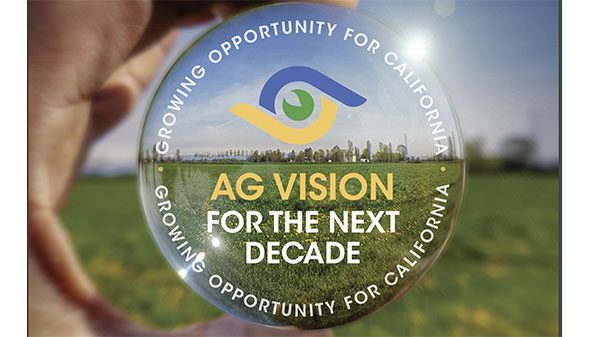The California Department of Food and Agriculture (CDFA) has released a document outlining its vision for the state’s farming industry over the next decade. It’s called Ag Vision for the Next Decade.
“Ag Vision is not just a plan for farmers and ranchers,” says an introductory statement. “It’s a plan for every Californian, from those who care about the land and landscape and making it better for the future, to those who work with or live around farming communities. It’s a plan for those curious about their food, those who buy fresh California fruit at their local grocery store, and those who receive nutritious dairy foods from their local food bank or school. It’s also a plan for young people looking to apply technology and innovation in new ways.”
The report says that the industry members who were interviewed cited such concerns as ag communication, changing demographics, climate change, inequities in farming, labor challenges, perception of agriculture, pushback on science, and regulatory pressures. Anyone who has followed California agriculture will recognize these as common themes.
The document sets out five “priority areas” where CDFA believes it can offer the most contribution to the future of the state’s agriculture:
- • Fostering “climate-smart, resilient, and regenerative food systems.”
- • Building “healthy, local communities.”
- • Driving “next-generation talent and tools.”
- • Enhancing public “understanding of agriculture.”
- • Collaborating on “smarter regulations.”
The report acknowledges that the term “regenerative agriculture” has no clear meaning that is widely accepted, adding, “Many believe regenerative approaches include those that help mitigate climate change, improve soil health, restore biodiversity, and enhance ecosystems.” It notes that the “regenerative” concept “moves beyond the philosophy of ‘do no harm’ to one of making things better.”
Of the report’s stated goals, the two that most closely reflect actual concerns of the state’s agriculture—at least as commonly voiced by its leadership—are regulatory concerns and public perceptions of the industry.
It is probably the case that California agriculture has to deal with regulatory strictures that are largely absent from other areas. A major complaint is the minimum wage, which is $15.50 per hour statewide. Ag leaders frequently contrast this high rate with the wages of states—such as many in the South—which have minimum wage rates no higher than the federal level of $7.25, putting California at a disadvantage in terms of labor costs. Ag sources also bemoan newly implemented rules mandating overtime pay for any hours worked above 40 per week.
The CDFA report emphasizes attracting and developing “next generation talent and tools.” This is of continued concern, especially as the American workforce continues to shrink as a result of baby boom retirements. But CDFA does not, and cannot, directly address the larger problem, which is getting and keeping all-important workers in fields and packing sheds. This is a labor issue that goes past CDFA’s mandate and indeed past the state’s borders.
As for building “healthy, local communities,” agricultural interests may support this broadly while disliking some proposed measures, including “Farmworker Resource Centers, which offer resources and access to services related to housing, health care, and labor rights.”
The most vexed issue addressed in the report is public perceptions of agriculture and ag’s mysterious but persistent inability to “tell our story” (to use the inevitable slogan).
But that is a subject that calls for discussion in a later column.
This article is the first in a two-part series.



